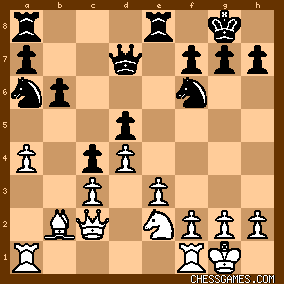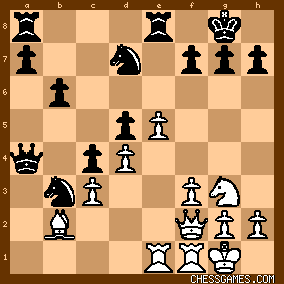|
< Earlier Kibitzing · PAGE 12 OF 20 ·
Later Kibitzing> |
| Aug-31-09 | | RandomVisitor: <psmith><May I make a suggestion? 25...Rf8 26.Qf4 Ne4 27.Qh6 looks good to me. Any thoughts?>On first look, 27...Qc6 seemed to allow black a chance to equalize, but deeper analysis shows that it is looking good for white. I will post in a few hours. |
|
| Sep-01-09 | | RandomVisitor: After 25...Rf8 26.Qf4 Ne4 27.Qh6:

click for larger view Rybka 3 :
[+0.50] d=19 27...gxf5 28.Qe6+ Rf7 29.Nxf5 Qd7 30.Nh6+ Kg7 31.Qxf7+ Qxf7 32.Nxf7 Kxf7 33.Rf1+ Nf6 34.Rf5 Nd2 35.Kf2 Kg6 36.Rf4 b5 37.Ke3 Nde4 38.Rf1 [+0.52] d=18 27...Rf6 28.Nxe4 dxe4 29.Rxe4 Rxf5 30.Re7 Rf7 31.Rxf7 Kxf7 32.Qxh7+ Kf6 33.Qh4+ Ke6 34.Qg4+ Kf6 35.Qf4+ Ke6 36.Qe4+ Kf7 |
|
| Sep-01-09 | | psmith: <RandomVisitor> Thanks. Your second line looks closer to equality to me. So I take it this still supports 25...Rf8 over 25...Re8. |
|
| Sep-01-09 | | Benzol: "Jose Raoul Capablanca (1888 - 1942) was always my idol. How else can one regard a man who, up to becoming World Champion, had lost only eight tournament games!" - Mikhail Botvinnik in 'Half a Century of Chess'. |
|
Sep-02-09
 | | LIFE Master AJ: There are all kinds of branches after 25...Rf8. However, I think that the analysis by <RandomVisitor> (and others) shows that White can still emerge with a solid edge. |
|
Sep-02-09
 | | LIFE Master AJ: Days of analysis has produced nothing superior to what has already been given here. |
|
Sep-02-09
 | | LIFE Master AJ: Rather than try to sift through all the analysis here ... I think I am going to add a link to my webpage. That way people can come here to check out the analysis. |
|
| Sep-02-09 | | RandomVisitor: After 25...Rf8 26.Qf4 Ne4 27.Qe5:
1: Mikhail Botvinnik - Jose Raul Capablanca, Netherlands It, Amsterdam (11) 1938

click for larger viewAnalysis by Rybka 3 :
<27...Qd7> 28.fxg6
± <(1.20) Depth: 23> 00:32:04 133172kN |
|
| Sep-02-09 | | Oliphaunt: <slomarko> you have to consider that this game was played in 1938, not 1920. |
|
| Sep-02-09 | | Whitehat1963: <slomarko> is being a bit uncharitable, to say the least. I don't think Botvinnik makes Capablaca "look stupid" here at all. He makes him look mortal. But, <slomarko>, you need to consider many other examples in which Capa plays divinely indeed! By the way, I can't think of a single instance in which Capa is actually made to "look stupid." He blundered in some simuls, just like any other great player, but no one, in a standard game, EVER made Capablanca "look stupid." |
|
Sep-02-09
 | | keypusher: <I just adore Botvinnik. I think I have a man-crush on a dead dour Soviet electrical engineer.> <JG27Pyth> I feel exactly the same way. Glad I am not the only one. |
|
| Sep-03-09 | | RandomVisitor: The whole Nb8-c6-a5-b3 Qxa4 concept seems misguided and allows white to build counterplay in the center and on the kingside. Black needs to try another plan: After 15.Qc2:
1: Mikhail Botvinnik - Jose Raul Capablanca, Netherlands It, Amsterdam (11) 1938

click for larger viewAnalysis by Rybka 3 : <23-ply> 1. = (-0.07): 15...Nh5 16.Bc1 g6 17.Qb1 Rad8 18.Re1 Nc7 19.Qb2 Ne6 20.Qb5 f5 21.Qb1 Nf6 22.f3 Nc7 23.Qc2 2. = (-0.05): 15...Rad8 16.Nf4 h6 17.Ba3 Rc8 18.Ne2 Nh5 19.a5 bxa5 20.Bc1 Qd8 21.Qa4 Nf6 22.Qxa5 Nc7 23.Qa4 Rb8 24.f3 Nb5 |
|
| Sep-03-09 | | AnalyzeThis: That was the GM opinion too - Capa had a plan, but it was the wrong plan. Against a lesser player than Botvinnik, it would have worked. |
|
| Sep-03-09 | | RandomVisitor: After 21.Qf2, white has a good position. If 21...g6 leads black to defeat, what other options does black have? After 21.Qf2, (21...g6 eliminated from consideration) 1: Mikhail Botvinnik - Jose Raul Capablanca, Netherlands It, Amsterdam (11) 1938

click for larger viewAnalysis by Rybka 3 :
<[+0.49] d=19 21...Qc6> 22.Nf5 a5 23.f4 b5 24.Re3 Kh8 25.Nd6 f6 26.Nxe8 Rxe8 27.Qc2 Qe6 28.f5 Qb6 29.e6 Ne5 01:01:11 175995kN |
|
| Sep-03-09 | | psmith: <RandomVisitor> I take it that after 21...Qc6 the more natural move is 22.f4 (planning f5-f6 and only then Nf5). My preliminary analysis shows that this is good for White. I will post more shortly. |
|
Sep-04-09
 | | LIFE Master AJ: There is now a link on my analysis of this game, (see http://www.ajschess.com/lifemastera...); back to this page. [See the note after move 25.] Note to <RandomVisitor> I spent many days of analysis working on my line - I let the computer run all night several times ... I never came up with a "complete refutation" of 25...Rf8; just a solid edge for White. |
|
| Sep-04-09 | | RandomVisitor: <LMAJ>Thanks for that - I am continuing my work on 25...Rf8 and will post more in a few days. |
|
| Sep-04-09 | | RandomVisitor: Here is what I am working on (incomplete):
After the possible improvement 25...Rf8 26.Qf4 Ne4 [forced] 27.Qe5 black has great problems: Analysis by Rybka 3 :
<27...Qd7> [+1.20] d=23 28.fxg6 hxg6 29.Nxe4 dxe4 30.Ba3 Rf7 31.Qxe4 Qf5 32.Qh4 Qh5 33.Qd8+ Kh7 34.Bd6 Qf5 35.Qh4+ Qh5 36.Qg3 a5 37.h3 g5 38.d5 a4 39.Ba3 Nc5 40.Bxc5 bxc5 41.d6 a3 32.Ra1 g4 43.Rxa3 <27...Qc6> 28.fxg6 hxg6 29.Nxe4 dxe4 30.Ba3 Rf5 31.Qb8+ Kg7 32.Bd6! Na5 and now perhaps 33.h3 and white should win |
|
Sep-05-09
 | | LIFE Master AJ: There is now a link on my page ... that points them directly to your post. (above) |
|
| Sep-05-09 | | RandomVisitor: Here is the final refutation of <25...Rf8>: After the possible improvement <25...Rf8> 26.Qf4 Ne4 [forced] 27.Qe5 black has apparently no way to draw: Analysis by Rybka3:
<I 27...Qd7>
28.fxg6 hxg6 [28...Nxg3 29.hxg3  ] ]
29.Nxe4 dxe4
30.Ba3 and now:
A. [+1.79] d=25 30...Rf7 31.Qxe4 Qf5 32.Qh4 Qh5 33.Re8 [Qd8 +1.80/21] Kh7 34.Qe1 Qf5 35.h4 Qf4 36.Be7 Nc1 37.Bg5 Nd3 38.Bxf4 Nxe1 39.d5 Nd3 40.Be3 g5 41.Bxg5 Kg6 42.d6 Rd7 43.Rd8 Rxd8 44.Bxd8 (21:57.13) 21752283kN B. 30...Re8 31.Qg5 Qf5 32.Qe3 scores +1.99/20 32...Qh5 33.Rf1 Qh4 34.h3; +2.16/20 32...Qa5 33.Bd6 Qd5 34.Be5 <II 27...Qc6> 28.fxg6 hxg6 29.Nxe4 dxe4 30.Ba3 Rf5 31.Qb8+ Kg7 32.Bd6! Na5 and now perhaps 33.h3 and white should win |
|
| Sep-05-09 | | psmith: <RandomVisitor>: going back to your earlier suggestion of 21...Qc6, I have looked at the plan of 22. f4 followed by f5. Aided by Fritz 5.32 I have looked at two lines. (Actually, I have looked at a lot more, but at the moment these seem most salient to me.) In the first, Black just ignores white and continues with his queen-side plan: 21... Qc6 22. f4 b5 23. f5 a5 24. Re3 b4 25. f6 gxf6 (25...g6 26. Nf5 Kh8 27. Nd6 Kg8 28. Qf4 Nbc5 29. dxc5 Qxc5 30. cxb4 axb4 31. Bd4) 26. Nf5 fxe5 27. Qg3+ Qg6 28. Nh6+ Kh8 29. Nxf7+ Kg8 30. Qh3 Nd2 31. Rg3 Nxf1 32. Rxg6+ winning In the second Black tries to organize a defense:
21... Qc6 22. f4 Qh6 23. f5 Nf8 24. f6 g6 25. Re3 Ne6 (25... b5 26. Kh1 a5 27. Ba3 Ne6 28. Nf5 gxf5 29. Rh3 Qd2 30. Qxf5 h6 31. Rg3+ Ng5 32. h4 b4 33. hxg5 Nxd4 34. cxd4 Qxd4 35. Qh3 winning. Any thoughts? |
|
| Sep-05-09 | | psmith: Sorry, the second line should go:
21... Qc6 0 22. f4 Qh6 23. f5 Nf8 24. f6 g6 25. Re3 Ne6 (25... b5 26. Kh1 a5 27. Ba3 Ne6
28. Nf5 gxf5 29. Rh3 Qd2 30. Qxf5 h6 31. Rg3+ Ng5 32. h4 b4 33. hxg5 Nxd4 34.
cxd4 Qxd4 35. Qh3) 26. Kh1 b5 27. Nf5 gxf5 28. Rh3 Qd2 29. Qxf5 Nf8 30. Ba3 Ng6
31. Qh5 h6 32. Rg3 Kh7 33. e6 Rxe6 34. Rxg6 fxg6 35. Qxd5 Rae8 36. Qd7+ winning. |
|
| Sep-05-09 | | RandomVisitor: <psmith>I have this as a deep look at 21...Qc6 - I am examining your suggestion of 22.f4: [+0.82] d=25 21...Qc6 22.Nf5 Qe6 23.Nd6 f5 24.g4 f4 25.Nxe8 Rxe8 26.Bc1 Rf8 27.Qh4 b5 28.Ba3 Re8 29.Qg5 Nb8 30.Qxf4 Nc6 31.Re2 a5 32.Bb2 b4 33.Qe3 a4 34.cxb4 Nxb4 35.Bc3 Nd3 36.Ra2 Qd7 (15:45.25) 11423569kN |
|
| Sep-05-09 | | RandomVisitor: After 21...Qc6 22.f4:
[+0.71] d=19 22...a5 23.Nf5 Nf8 24.Re3 (0:17.21) 189506kN |
|
Sep-05-09
 | | LIFE Master AJ: <Random Visitor> Thanks for all your hard work. My initial judgment was that 25...Rf8; while perhaps ONLY SLIGHTLY SUPERIOR to 25...Re8; it should still not be enough to save the game. (My logic? It did not fundamentally change the nature of the position.) |
|
 |
 |
|
< Earlier Kibitzing · PAGE 12 OF 20 ·
Later Kibitzing> |





